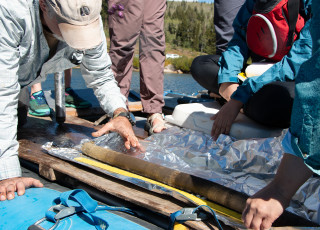Take Time to Walk Among the Wildflowers this Spring
NHMU Botany Collections Manager Allison Izaksonas is an expert on finding spring flowers around the city. ©NHMU
By Riley Black
Everywhere you look, Utah is in bloom. From the streetcorners of Salt Lake City to the foothills along the Wasatch Front, plants of all sorts are putting out gorgeous displays of flowers. And even though identifying these plants can be something of a challenge for aspiring botanists, NHMU botany collections manager Allison Izaksonas is here to help.
If you want to take in some of the fleeting floral color that blooms this time of year, taking a walk along the various Wasatch foothill paths - like the Bonneville Shoreline Trail outside NHMU - is a great way to get started. You won't even have to walk very far before you start spotting yellow, sunflower-like plants called arrowleaf balsamroot. These plants aren't actually sunflowers, Izaksonas notes, but can be told apart by the fact that they grow low to the ground and have heart-shaped leaves.
Even as warm, late spring temperatures start to climb, you're likely to catch some other remarkable wildflowers, too. Utah milkvetch is another favorite at this time of year. "This plant is very cool because this is one of our very local Utah plants," Izaksonas says, as the plant is primarily found along the Wasatch Range. The plant's bright pink flowers stand out, and you can also tell it apart by the fact that its leaves have tiny leaflets stemming off from each. Just don't try to eat them, Izaksonas cautions - milkvetch plants are very toxic.
If you really do want a taste of nature, though, you might want to look out for sagebrush bluebells. These plants are found throughout the western United States, and you can easily tell them apart by blue, bell-shaped flowers that hang down from the plat. "You can pluck a leaf off and eat it raw," Izaksonas says - the flavor is something like lettuce with a little seafood aftertaste.
And if you do go flower foraging, you might want to consider what ethical foraging means as you hike along. "We all want these amazing plants to keep thriving into the future and maintain healthy populations," Izaksonas says. Here are some helpful guidelines to keep in mind:
- Flowers and leaves are very important to the survival of individual plants and plant populations, so don't take more than ten percent of the leaves, fruits, or flowers from an individual plant or a plant population.
- Try to avoid taking roots or bark from plants, as doing so might fatally harm the plant.
- Plants introduced for food and medicine are common and often grow alongside native species. If you really want to forage, take from the non-native species first.
- Harvest from a place of respect, kindness, and humility for both the plants and the ecosystem they're a part of.
But you don't have to forage to fully appreciate the amazing array of plants blooming around our city right now. Sometimes just understanding a little bit more about the plants that grow in and around our city can be its own kind of treasure hunt, and, Izaksonas says, apps like iNaturalist can help you learn even more as a citizen scientist. Now's the time to get out, so find a comfy pair of hiking shoes and hit the hills to stop and smell - or even catalog - some of the flowers.
Riley Black is the author of Skeleton Keys, My Beloved Brontosaurus, Prehistoric Predators, and is a science writer for the Natural History Museum of Utah, a part of the University of Utah in Salt Lake City. Our mission is to illuminate the natural world and the place of humans within it. In addition to housing outstanding exhibits for the public, NHMU is a research museum. Learn more.



